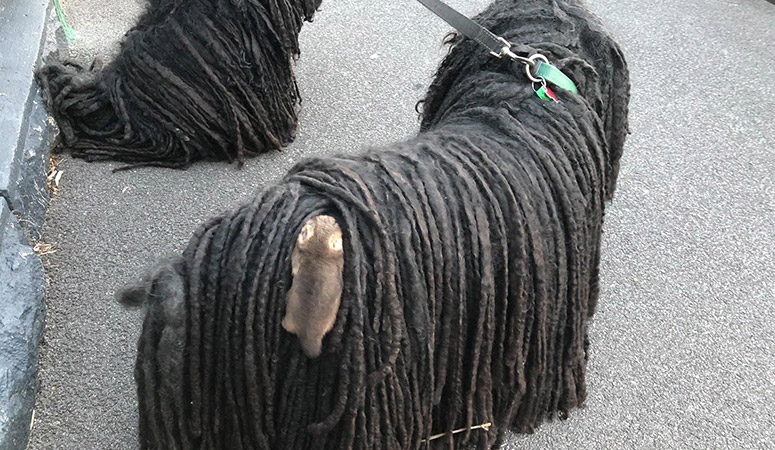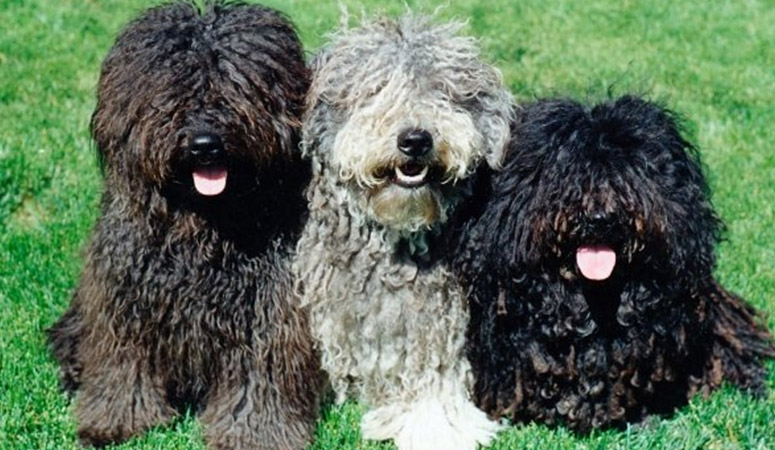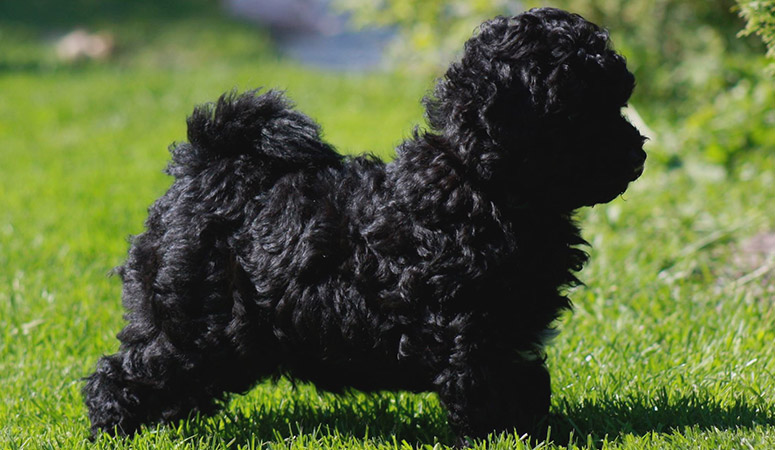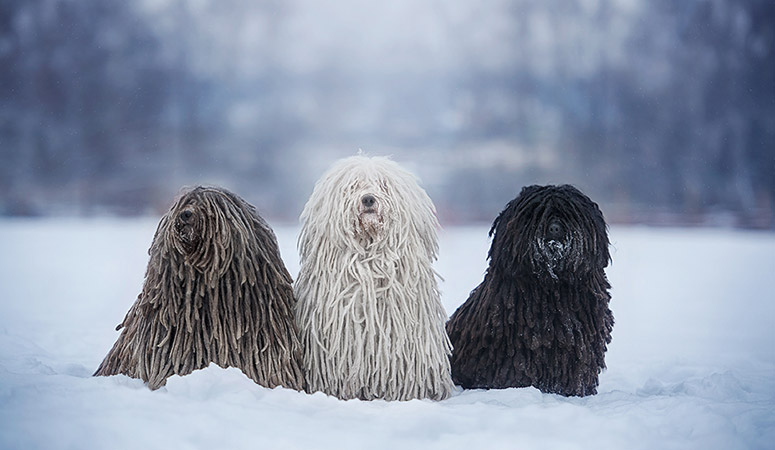Puli
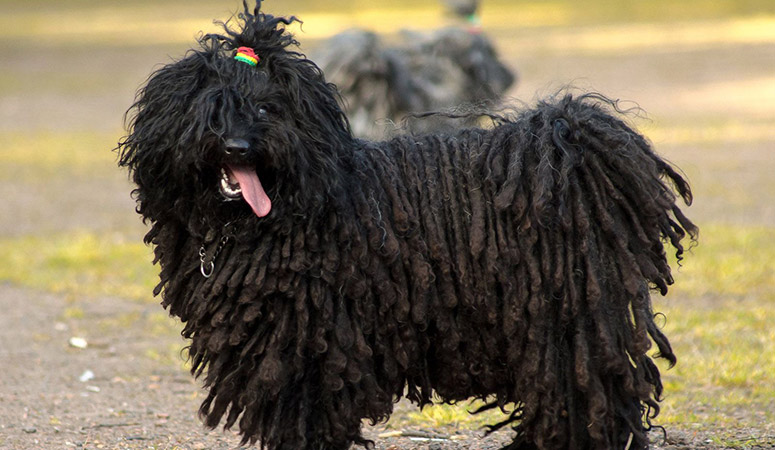
The Puli is a small-medium breed of Hungarian herding and livestock guarding dog, they are best known for their long, corded coat resembling dreadlocks. The dog is often quick, agile and can change directions instantly, these active and faithful little dynamos are quick learners.
| Other Names | Hungarian Puli |
| Color | Black, Silver, White, Brown, Cream, Rust |
| Height | Males: 15-18 inches. Females: 14-17 inches. |
| Weight | Males: 28-33 pounds. Females: 22-29 pounds. |
| Life Span | 10-15 years |
| Personality | Loyal, Smart, Home-Loving |
| Exercise | Regular Exercise |
| Origin |
| Popularity | #160 |
| Groom Needs | Specialty/Professional |
| Kids Friendly | Yes with supervision |
| Dog Friendly | Yes with supervision |
| Watch Dog | Yes |
| Family Dog | |
| Litter Size | 4-6 |
Puli Pictures
Puli Video
Introduction
Pulik is a term for a group of Puli dogs. Pulik are intelligent and energetic dogs that detest being kept in a small space due to their exuberance. They can easily get resentful if they don’t get enough room for expending their energy. Obedience training is required for puppies as early as possible. Pulik come in a thin, corded double coat (weatherproof), the corded nature of which is believed to be the result of a controlled matting process. They are usually black in color, although other less common varieties exist in white, cream, or gray color.
Male Pulik stand around 16-17 inches tall, measured from shoulder to paw, while a full-grown female is likely to measure around 15-16 inches at the shoulder, appearing only slightly smaller than the male. A standard Pulik should weigh around 23-35 pounds, regardless of gender. Pulik are friendly and loyal to their family. They have an average lifespan of 10-14 years.
Living with Puli
The Puli can be kept corded, brushed, or with a clipped coat. Until a Puli puppy is 8 to 10 months old, there is no grooming to do except for regular bathing and ears, and grinding toenails. Their undercoat is soft, woolly, and dense, and the hair clumps easily and if left to itself will form woolly cords as the dog matures. And the cords may be flat or round depending on the coat’s texture and the amount of undercoat and outer coat. It takes four to five years to grow out completely and may eventually reach the floor.
The Puli coat can be brushed or left to the cord. You need to start early and brush the dog’s coat if you plan to brush the coat rather than let it cord. Once the coat has distinct cords, all you do is bathe the dog when needed and separate the cords. Be sure your dog is dry all the way down to the skin or he will smell as if he has mildewed.
The Puli is a high-drive dog that requires both physical and mental stimulation. Actually, mental exercise is as important as physical exercise for this breed. Exercise and playtime aside, the Puli may be expected to chill out with the family on the couch. They are loyal companions who enjoy being with people and they shouldn’t be permanently relegated to the backyard. For an active family, the Puli would be excited with romps in the yard, a bit of fetch, and maybe a hike in the woods. Without proper exercise, your dog may become anxious and destructive. Besides, they can do well in canine sports, such as herding, obedience, and agility, among other activities.
Generally, it is recommended to feed the Puli with one to two cups of high-quality dry dog food every day, divided into two meals. And there should be clean and fresh water at all times. More importantly, the food amount should depend on the dog’s weight, size, age, and activity level.
Some dogs are easy to get overweight, so you need to watch their calorie consumption and weight level all the time. Treats may be an important aid in training, but excessive intake can lead to obesity. Also, owners need to distinguish which human food is safe for dogs and which are not. If you have any problems with your dog’s weight or diet, just consult from your veterinarian.
The Pulis are prone to the following health conditions: Hip Dysplasia, Progressive Retinal Atrophy, Cataracts, etc.
Major concerns: CHD
Minor concerns: none
Occasionally seen: patellar luxation, deafness, PRA, degenerative myelopathy
Suggested tests:
Hip Evaluation
Patella Evaluation
Ophthalmologist Evaluation
Degenerative Myelopathy DNA Test
Total Annual Cost: $2889
Cost is estimated for the first year and may vary depending on many factors, such as dog food, health care, leash, collar, licensing, possible fencing, crates, training and obedience classes, dog-walking, grooming, treats, toys, flea, tick, and heart-worm meds, microchips, etc.
Pulik are extremely intelligent, agile, and loyal, which makes them able to learn quickly, and they are very eager to please their owners. Firm and consistent training are necessary for this breed, and all training should be done using positive methods and treats based reward system. Also, early socialization and proper training are important to the strong-willed Puli, so they can learn good canine manners. Besides, the agile Puli is a good candidate for many canine sports, especially herding tests, agility, and obedience competition, and many of them have even gone with the special training and become certified as therapy dogs or water rescue dogs.
History
The Puli is a breed from Hungary, which is believed to have originated in the period of the Magyars migration from Central Asia. They were one of the herdings and guarding breeds of early Hungarian dogdom, often working in alliance with the much larger Komondor (plural, Komondorok). Peasants usually employed the services of both dog breeds in the herding and guarding of their cattle, sheep, and other livestock. The Puli was mainly engaged with the herding and guarding job in the day, while the Komondorok took a nap. At night, the Komondorok assumed territorial dominion, gallantly patrolling the farmstead to ensure maximum security of stock. What’s more, the Puli has a similar corded coat with the Komondor.
The ancestors of the modern Puli are believed to have been Hungarian shepherd dogs, probably brought into the Carpathian basin about a thousand years ago. The Puli was a popular herding dog until the era of intensive farming in Hungary, when they lost their role on the flock, and were more or less forgotten for a long time. Later, in the 20th century, they resurfaced but this time, not on the farms, rather at home as the good-natured house dog. Pulik became even less favored as housepets after the Second World War.
The first set of Pulik entered America in the mid-1930s, a period when farmers in the U.S were faced with the problem of herd dogs killing the livestock they were meant to herd or protect. The Pulik was bred with a few other breeds including the German Shepherd and when tested, were found to do better than other herding breeds.
Helpful Information
Breed Club: PULI CLUB OF AMERICA, INC.
Breed Club Link: http://www.puliclub.org/
Breed Club Rescue: PCA Rescue Trust
Breed Club Rescue Link: http://www.pulirescue.org/

